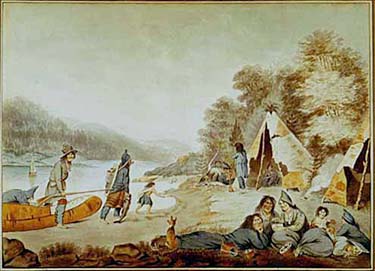|
|
Canku Ota |
|
|
(Many Paths) |
||
|
An Online Newsletter Celebrating Native America |
||
|
November 16, 2002 - Issue 74 |
||
|
|
||
|
This Date In |
||
|
North American Indian History |
||
|
from On This Date in North American Indian History at http://americanindian.net |
||
| Nov. 16, 1811: |
According to some sources,
Tecumseh predicts a "light across the sky" tonight. It is supposed to
have appeared, as predicted.
|
|
|
|
| Nov. 17, 1938: |
An election is authorized to approve a Constitution and By-Laws
for the Thlopthlocco Tribal Town of the Creek Indian Nation of the State
of Oklahoma by Oscar Chapman, Assistant Secretary of the Interior. The
election is held on December 27, 1938.
|
|
|
|
| Nov. 18, 1813: |
Members of the Hillabi Clan
of the Muskogee Creeks have offered to surrender to General Andrew Jackson
with Scots trader Robert Grierson acting as intermediary. Jackson agrees
to the surrender. However, forces under Generals Hugh White and John
Cocke are unaware of the agreement. They attack Hillabee village, which
believes the fighting is over. Five dozen Hillabis are killed, and 250
are captured. This action reverses the Hillabis' decision to surrender.
They become one of the most fierce fighting units in the Creek War.
|
|
|
|
 The Northwest Territory 1787 (click here for a larger image) |
|
| Nov. 19, 1794: |
According to the Jay Treaty
and Northwest Territory Treaty, Indians can cross borders.
|
|
|
|
| Nov. 20, 1969: |
"Indians of all tribes" are declared on Alcatraz Island.
|
|
|
|
| Nov. 21, 1807: |
Spanish trader Manuel Lisa builds Fort Raymond at the confluence
of the Yellowstone and Bighorn Rivers. This is in central Montana near
modern Custer.
|
|
|
|
|
|
|
| Nov. 22, 1752: |
The "Mick Mack" of Nova Scotia sign a treaty with the British. |
|
|
|
| Nov. 23, 1877: |
While authorities are attempting
to arrest an Indian named Naught, who is accused of shooting two teamsters,
other Indians become agitated. One of them shoots Alex Rhoden, who is
walking across the street at the time, in Nalad City, Idaho. This incident
leads to the Bannock War.
|
|
|
|
| Nov. 24, 1812: |
As a young boy, Spemicalawba (called Captain Logan or High Horn), is captured by General James Logan. General Logan raises him until he is returned to the Shawnee during a prisoner exchange. Tecumseh's nephew, he tries to temper Tecumseh's feelings toward the Europeans. Spemicalawba scouts for the Americans during the war of 1812. He is killed on this date during a scouting expedition. Buried with military honors, Logansport, Indiana is named after him. |
|
|
|
| Nov. 25, 1894: |
A group of nineteen Hopi "hostiles"
are placed under arrest by the army for interfering with "friendly"
Hopi Indian activities on their Arizona reservation. The nineteen prisoners
will be held in Alcatraz prison in California from January 3, 1895 to
August 7, 1895.
|
|
|
|
| Nov. 26, 1835: |
Charley Emathla is killed.
Emathla signs the agreement at Fort Gibson in Indian Territory (present
day Oklahoma) committing the Seminoles to their removal from Florida.
He is in favor of the removal. He is killed by Seminoles who are against
the treaty or leaving Florida. Many believe that he is killed by Chief
Osceola. This is the first in a series of killings.
|
|
|
|
 Decorated Blackfoot tipis, [ca. 1900-1903] Glenbow Archives NA-919-37 |
|
|
Nov. 27, 1915:
|
Private Albert Mountain Horse
is buried in Fort Macleod, Alberta. He is the only Blood Indian to go
to the front lines in World War One. He dies due to exposure to poison
gas on the battlefield.
|
|
|
|
|
Nov. 28, 1745:
|
The old frontier settlement
of Saratoga, New York is near modern Schuylerville. 220 Indians, and
400 French attack the settlement. Most of the town, and the fort, is
burned, 100 settlers are captured, and another thirty are killed during
the fighting.
|
|
|
|
|
Nov. 29, 1641:
|
The Abenaki sign a peace treaty with the British. Benjamin Church has been skirmishing with then since September in the vicinity of Saco, in southern Maine. The Abenaki agree to a six month truce, to release their English prisoners, and to keep the British aware of the movements of the French in the area. |
|
|
|
|
For Information on This Date in Canada visit our friends at: |
|
Canadian
Aboriginal News |
|
|
||
|
|
||
| Canku Ota is a free Newsletter celebrating Native America, its traditions and accomplishments . We do not provide subscriber or visitor names to anyone. Some articles presented in Canku Ota may contain copyright material. We have received appropriate permissions for republishing any articles. Material appearing here is distributed without profit or monetary gain to those who have expressed an interest. This is in accordance with Title 17 U.S.C. section 107. | ||
|
Canku Ota is a copyright © 2000, 2001, 2002 of Vicki Lockard and Paul Barry. |
||
|
|
|
|
|
The "Canku Ota - A Newsletter Celebrating Native America" web site and its design is the |
||
|
Copyright © 1999, 2000, 2001, 2002 of Paul C. Barry. |
||
|
All Rights Reserved. |
||

